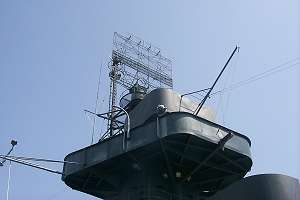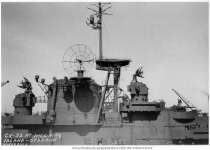SK
Description of the radar set, tactical-technical characteristics

Figure 1: SK Air search radar at Battleship Texas (BB-35), © 2002 P. R. Yarnall, NavSource Naval History.

Figure 1: SK Air search radar at Battleship Texas (BB-35),
© 2002 P. R. Yarnall,
NavSource Naval History.
 Manufacturer:
Manufacturer:General Electric
| Specifications | |
|---|---|
| frequency: | 200 MHz
( VHF-Band) |
| pulse repetition time (PRT): | |
| pulse repetition frequency (PRF): | |
| pulsewidth (τ): | 5 µs |
| receive time: | |
| dead time: | |
| peak power: | 200 … 250 kW |
| average power: | |
| instrumented range: | 162 mi (≙ 300 km) |
| range resolution: | 550 m |
| accuracy: | ±90 m, ±3° |
| beamwidth: | 10° |
| hits per scan: | |
| antenna rotation: | 4.5 rpm |
| MTBCF: | |
| MTTR: | |
SK
The SK was an US-American air search radar set using on large ships at the end of World War II. It was essentially an SC-2 radar set with a larger antenna with 6×6 dipoles (15 ft × 16 ft 9 in., ≙ 4,57 × 5,10 m). The radar was capable of detecting a medium bomber at 10 000 feet and 100 nautical miles. There was no elevation control but elevation could be estimated roughly from positions of maximum, and minimum signal strength of the difference of the signals between the antenna rows. The radar used an A-scope with 15 miles (≙ 24 km), 75 miles (≙ 120 km) or 375 miles (≙ 600 km) range scale, and a PPI-scope with 20 miles (≙ 32 km), 75 miles (≙ 120 km) or 200 miles (≙ 320 km) range scale.
Identification Friend or Foe (IFF) was provided by the vertically polarized antenna atop the main antenna. It used the IFF-Standard Mark IV.
A later version was named SK-2 and used a large parabolic antenna fed by a dipole.
The SK became operational in 1943 and was mainly used on carriers, destroyers and escorts (rarely used on battleships), predominantly in the Pacific theater of war. It replaced the CXAM-1 radar set. About 250 SK radar sets were produced until the end of the war.

